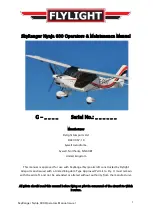
Dangerous situations and extreme flying
Section 7
31
Tips on the manoeuvres
If you would nevertheless like to fly at the
limits of the APUS RS in a safety training
course, then you should provoke the
asymmetric collapse and the front stall
dynamically with high force input. If the
manoeuvre occurs too sluggishly and
without enough force, then the canopy may
pre-accelerate. This can cause uncontrolled
flight positions.
Special lines are not required for carrying
out the various manoeuvres.
Collapsing the paraglider
Asymmetric collapse
Asymmetric collapses are caused by the
stagnation point moving to the trailing edge
of the glider. A negative angle of attack
makes part of the canopy collapse and tuck
under, and the glider may plunge down, turn
away or spin.
Recovery
Should an asymmetric collapse occur,
counter-brake slightly on the side of the
glider that is still inflated to stop it turning
away and to stabilise it, until the glider flies
straight ahead again. With large asymmetric
collapses, it is important to counter-steer
carefully so that the glider does not stall
completely and go into a full stall.
The part of the glider which has collapsed
generally re-inflates automatically but this
can be assisted by applying light brake
pressure on the collapsed side (but not
hectic “pumping”) while counter-steering on
the opposite side. Make use of the full
braking distance.
Following a very large collapse of more than
70%, the wing-tip of the collapsed side may
become trapped in the glider lines. Here too
counter-braking and weight-shifting must be
used to stop the glider from turning away.
The trapped end can generally be opened
by a short, fast pull on the brake lines or by
pulling on the separate stabilo lines.
Front stall
A negative angle of attack can also cause
part or all of the leading edge of the glider to
collapse.
Recovery
The APUS RS will normally recover quickly
and automatically from a front stall, but re-
inflation
can
be
assisted
by
light
symmetrical brake input. In the case of
extreme front stalls across the entire wing
chord, the wing tips may move forward
making the glider form a U-shape. Again,
recovery is by light symmetrical braking on
both sides, but care must be taken that both
wing ends return to normal flight evenly.
Types of stall
When a paraglider flies through the air, a
laminar and turbulent boundary layer is
created.
Extremely
dangerous
flight
configurations can result if the laminar
boundary
layer
is
interrupted,
with
practically the entire airflow along the top
surface braking away. This happens in
particular when the angle of attack is too
great.
There are three different types of stall in
paragliding.
WARNING
Counter-steering too strongly on the
inflated side of the glider can result in a
stall and to further uncontrolled flight
manoeuvres (cascade of events).














































